Medicine
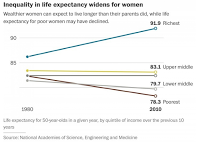
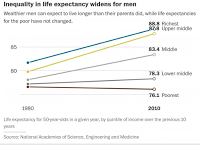
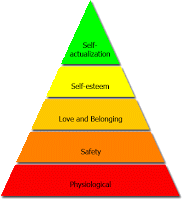 In addition, education does not take place only in school. Children from upper-income families are more likely to have educated parents, who not only encourage them to pursue educational success, but read to them and talk to them from the very beginning of their lives. These are also families in which survival needs do not displace the priority of children getting an education. In 1943, the psychologist Abraham Maslow published his hierarchy of needs; survival must come before self-actualization. This was originally conceived of for the individual, but is also true of families and communities. A similar pyramid has been developed to describe the impact of Adverse Childhood Events (ACEs). ACEs are a ways of thinking about the combination of negative impacts including hunger, homelessness, physical abuse, sexual abuse, neighborhood dangerousness, etc., that have been shown to have a lifelong negative impact. In addition to being associated with higher future rates of drug abuse and mental illness, they are associated with higher rates of just about everything bad. The Adverse Childhood Experiences studyconducted by Kaiser Permanente beginning in 1995-97 is the most significant study on this topic. It is ongoing and being replicated in many other countries.
In addition, education does not take place only in school. Children from upper-income families are more likely to have educated parents, who not only encourage them to pursue educational success, but read to them and talk to them from the very beginning of their lives. These are also families in which survival needs do not displace the priority of children getting an education. In 1943, the psychologist Abraham Maslow published his hierarchy of needs; survival must come before self-actualization. This was originally conceived of for the individual, but is also true of families and communities. A similar pyramid has been developed to describe the impact of Adverse Childhood Events (ACEs). ACEs are a ways of thinking about the combination of negative impacts including hunger, homelessness, physical abuse, sexual abuse, neighborhood dangerousness, etc., that have been shown to have a lifelong negative impact. In addition to being associated with higher future rates of drug abuse and mental illness, they are associated with higher rates of just about everything bad. The Adverse Childhood Experiences studyconducted by Kaiser Permanente beginning in 1995-97 is the most significant study on this topic. It is ongoing and being replicated in many other countries.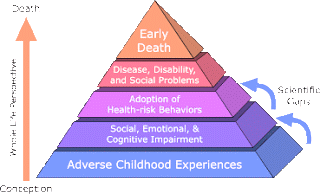
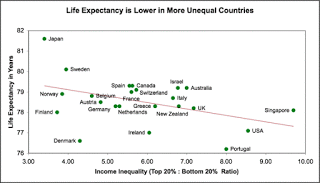 Wealthy people have a longer life expectancy than poor people, and wealthy countries have longer life expectancies than poorercountries, and those with wider gaps between the rich and poor have wider gaps in life expectancy; in this regard the US is at greater risk than wealthy nations with smaller gaps. The neat interactive website from Gapminder allows you to track wealth with life expectancy over time since 1800. The GINI index measures the income disparities within countries, and its use allows correlating income inequality with life expectancy; like several other health measures (e.g., infant mortality) life expectancy goes down with increasing inequality even when a country (such as the US) is rich overall.
Wealthy people have a longer life expectancy than poor people, and wealthy countries have longer life expectancies than poorercountries, and those with wider gaps between the rich and poor have wider gaps in life expectancy; in this regard the US is at greater risk than wealthy nations with smaller gaps. The neat interactive website from Gapminder allows you to track wealth with life expectancy over time since 1800. The GINI index measures the income disparities within countries, and its use allows correlating income inequality with life expectancy; like several other health measures (e.g., infant mortality) life expectancy goes down with increasing inequality even when a country (such as the US) is rich overall.
And the first step is recognizing and acknowledging it.
- Status Syndrome: An Important Determinant Of Health
This is a guest post by Linda French, MD, who is Chair of the Department of Family Medicine at the University of Toledo School of Medicine. In a recent blog (Keeping immigrants and all of us healthy is a social task), May 19, 2013), my good friend Josh...
- Keeping Immigrants And All Of Us Healthy Is A Social Task
The Health Toll of Immigration, by Sabrina Tavernise in the May 19 New York Times, documents the decreased life expectancy and worse overall health that accompany immigration to the United States. Focusing on Mexican immigrants in the border city of...
- To Improve Health The Us Must Spend More On Social Services
That the US spends far more, in total and per capita, on health care than any other country is a well-established fact which no one bothers to deny. That this expenditure has not brought us greater health is also established fact, although many still...
- Health Outcomes: The Interaction Of Class And Health Behaviors
. I have recently discussed (Poverty, Primary Care and the Cost of Medical Care, February 10, 2010) the “Whitehall Studies” conducted by Sir Michael Marmot and colleagues that “demonstrate that there is a more or less linear correlation between...
- Health Disadvantages Of Americans Compared To Europeans
I have written often about the absurd non-system of health care and health insurance that exists in the United States, and unabashedly argued for (and, I hope, supported these arguments with data) a single-payer health system such as that that exists...
Medicine
More wealth, more health: what can we do to mitigate disparities?
The Washington Post’s “Wonkblog” reviewed a report by economists discussing “The stunning — and expanding — gap in life expectancy between the rich and the poor” (Max Ehrenfreund, Sept 18, 2015). One focus of the article, which is based on a report from the National Academy of Sciences, is that (in the words of the alternative title of the Wonkblog piece that displays in the URL), “the government is spending more to help rich seniors than poor ones”. A big reason for this is that the greater life expectancy of the more well-to-do means that they collect benefits from Social Security and Medicare for longer. But, of course, the real issue is that there is such a difference in the life expectancy of rich and poor. Ehrenfreund illustrates this with two dramatic graphs:


This is a pretty significant difference. What are the reasons for it? The report (and the article based on it) indicate that while differences in “lifestyle” (smoking and obesity, mainly) account for some of the difference, it is less than 1/3. The study also alludes to the impact of “stress”. This may seem vague, non-specific, or ubiquitous: aren’t we all stressed? Don’t rich people have a lot of stress because wealth is often accompanied by great responsibility? Such interpretations sometimes leads "stress" as a factor in longevity to be discounted by many commentators. But the impact of stress on health is a real thing, and it is well documented. Many people are familiar with the old terms “Type A” and “Type B” personalities, and how being Type A (more stressed) can lead to a greater risk of disease, particularly heart attack. But the real concern is a kind of stress that is more common in poorer people. This is the continuousstress, from worrying about whether you and your family will have enough food to eat and a place to live, whether you will have a job, whether it is safe to walk down the street, whether (especially if you are a young Black man) the police are going to stop you at any moment, that has major negative health effects. The mechanisms through which this occurs are incompletely elucidated, but certainly involve the neuroendocrine system, the release of hormones that prepare the body for “fight or flight” by refocusing blood flow to muscles, increasing heart rate, etc. Such a response is very useful in an emergency, but when it is happening most or all of the time, and the body does not have the time and rest to fully recuperate, it results in real health damage. This hormonal response allows a person to run fast, from an attacker or for sport, for a short time, but if the challenge never stops, the body eventually wears out
This sort of stress on the body may be the “final common pathway” through which many of the negative life situations that poorer people are more likely to find themselves in exact their toll, but there are also other factors. People’s health, and thus their life expectancy, is to a large extent determined by their early childhood experience. The relative income of their families of origin that affects their childhood nutrition and education, their warmth in the winter, and the amount of transmitted stress that their parents felt, is also a big determinant. While this disparity at the start of life is something that can be mitigated, by some, through future success, it can never be completely erased. That is, while rich people from poor backgrounds may have better health later in life than those who stay poorer, they have on average worse health than those who started out wealthy and stayed that way. “Choose your parents wisely,” I tell my medical students, “if they are both long-lived and rich, it bodes well for your future health.” Luckily for them, the majority of medical students come from at least upper-middle-income families.
Another big determinant is education, and many studies show the correlation of higher levels of education with longer life and better health. Of course, education is highly correlated with income, both on the front end (children from higher-income families are more likely to achieve higher educational levels) and on the back end (those children from families of lower socioeconomic status who are successful have usually become so through education). In the US, income is related to education in part because our schools are largely funded by local tax bases, so that wealthier people live in better funded, and educationally better, school districts. People from other countries often have difficulty understanding that we have “good” and “bad” school districts; as one friend said “where I come from all schools are the same! No one would choose where to live based on the quality of the schools!” This concept is so alien to me that I had difficulty understanding them!
 In addition, education does not take place only in school. Children from upper-income families are more likely to have educated parents, who not only encourage them to pursue educational success, but read to them and talk to them from the very beginning of their lives. These are also families in which survival needs do not displace the priority of children getting an education. In 1943, the psychologist Abraham Maslow published his hierarchy of needs; survival must come before self-actualization. This was originally conceived of for the individual, but is also true of families and communities. A similar pyramid has been developed to describe the impact of Adverse Childhood Events (ACEs). ACEs are a ways of thinking about the combination of negative impacts including hunger, homelessness, physical abuse, sexual abuse, neighborhood dangerousness, etc., that have been shown to have a lifelong negative impact. In addition to being associated with higher future rates of drug abuse and mental illness, they are associated with higher rates of just about everything bad. The Adverse Childhood Experiences studyconducted by Kaiser Permanente beginning in 1995-97 is the most significant study on this topic. It is ongoing and being replicated in many other countries.
In addition, education does not take place only in school. Children from upper-income families are more likely to have educated parents, who not only encourage them to pursue educational success, but read to them and talk to them from the very beginning of their lives. These are also families in which survival needs do not displace the priority of children getting an education. In 1943, the psychologist Abraham Maslow published his hierarchy of needs; survival must come before self-actualization. This was originally conceived of for the individual, but is also true of families and communities. A similar pyramid has been developed to describe the impact of Adverse Childhood Events (ACEs). ACEs are a ways of thinking about the combination of negative impacts including hunger, homelessness, physical abuse, sexual abuse, neighborhood dangerousness, etc., that have been shown to have a lifelong negative impact. In addition to being associated with higher future rates of drug abuse and mental illness, they are associated with higher rates of just about everything bad. The Adverse Childhood Experiences studyconducted by Kaiser Permanente beginning in 1995-97 is the most significant study on this topic. It is ongoing and being replicated in many other countries.
Of course, lower income people are exposed to other risks beyond these. People living in “worse” neighborhoods have a greater likelihood of being homicide victims. Those neighborhoods are much more likely to be exposed to environmental pollutants in the air and water and even from the earth (such as toxic waste dumps). Many lower-income people work in more dangerous jobs, especially true in rural areas (farming, ranching, logging, highway construction, etc.) Indeed, the potential for “confounding” results from such exposures was the reason that Michael Marmot and his colleagues did their classic series of studies showing the direct correlation of higher socioeconomic status (class) and better health by examining people who worked for the government in the same offices in London (thus the name “the Whitehall studies”).
 Wealthy people have a longer life expectancy than poor people, and wealthy countries have longer life expectancies than poorercountries, and those with wider gaps between the rich and poor have wider gaps in life expectancy; in this regard the US is at greater risk than wealthy nations with smaller gaps. The neat interactive website from Gapminder allows you to track wealth with life expectancy over time since 1800. The GINI index measures the income disparities within countries, and its use allows correlating income inequality with life expectancy; like several other health measures (e.g., infant mortality) life expectancy goes down with increasing inequality even when a country (such as the US) is rich overall.
Wealthy people have a longer life expectancy than poor people, and wealthy countries have longer life expectancies than poorercountries, and those with wider gaps between the rich and poor have wider gaps in life expectancy; in this regard the US is at greater risk than wealthy nations with smaller gaps. The neat interactive website from Gapminder allows you to track wealth with life expectancy over time since 1800. The GINI index measures the income disparities within countries, and its use allows correlating income inequality with life expectancy; like several other health measures (e.g., infant mortality) life expectancy goes down with increasing inequality even when a country (such as the US) is rich overall. So yes, our Social Security and Medicare systems mean that those who live longer will have more financial benefit, and that they are more likely to be more well-to-do than those who die younger. In addition, those who are poorer are more likely to live longer with disability. But the real news is that poverty and social deprivation work in many synergistic ways to decrease the health of the poor. This is what we need a coordinated and comprehensive strategy to address.
- Status Syndrome: An Important Determinant Of Health
This is a guest post by Linda French, MD, who is Chair of the Department of Family Medicine at the University of Toledo School of Medicine. In a recent blog (Keeping immigrants and all of us healthy is a social task), May 19, 2013), my good friend Josh...
- Keeping Immigrants And All Of Us Healthy Is A Social Task
The Health Toll of Immigration, by Sabrina Tavernise in the May 19 New York Times, documents the decreased life expectancy and worse overall health that accompany immigration to the United States. Focusing on Mexican immigrants in the border city of...
- To Improve Health The Us Must Spend More On Social Services
That the US spends far more, in total and per capita, on health care than any other country is a well-established fact which no one bothers to deny. That this expenditure has not brought us greater health is also established fact, although many still...
- Health Outcomes: The Interaction Of Class And Health Behaviors
. I have recently discussed (Poverty, Primary Care and the Cost of Medical Care, February 10, 2010) the “Whitehall Studies” conducted by Sir Michael Marmot and colleagues that “demonstrate that there is a more or less linear correlation between...
- Health Disadvantages Of Americans Compared To Europeans
I have written often about the absurd non-system of health care and health insurance that exists in the United States, and unabashedly argued for (and, I hope, supported these arguments with data) a single-payer health system such as that that exists...
